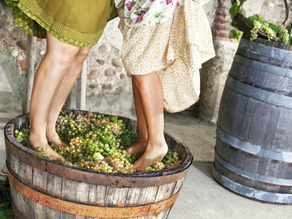Bob's Blog #11 Can You Crush Grapes with Dirty Feet?
- Robert Dolci
- Jan 16, 2023
- 3 min read

As you know, several of our members have been attempting to make wine from grape juice concentrate. The kits come with ingredients and reasonably good directions. That said, we all seem to end up making the wine somewhat differently. The ingredients supplied include yeast, yeast nutrient, kieselsol & chitosan (clarifiers), potassium metabisulfite, and potassium sorbate. I got to thinking about how wine was made in ancient times when all that stuff wasn’t available. Did the winemakers sterilize all the equipment, bottles, etc.? Our directions tell us what temperature range we must ferment at during the primary stages of fermentation and at what temperature range for secondary fermentation. We track the brix and specific gravity of the wine. Complicated stuff. Modern wine makers check the alcohol percentage, acidity, residual sugar, and total sulfur, among other tests. By knowing these values, winemakers can perfectly craft the ideal wine, right down to the chemical level. Other modern processes include filtration, blending, and adding preservatives. “Modern” wine waking has evolved in the last few centuries. Well, actually it has evolved over thousands of years.
How long have we humans been making wine? Oh, about 8,000 years. How was wine made back then when they did not have all the ingredients and devices that we have today? Did the wine taste bad? For the most part, ancient wine was drunk fresh- or as fresh as anything fermented could be.
A little history:
Georgia, by most wine historians is considered the birthplace of wine. Archaeologists have traced the world’s first known wine creation back to the people of the South Caucasus in 6,000BC. These early Georgians discovered grape juice could be turned into wine by burying it underground for the winter. Not that that is what they had in mind. I tend to believe that their intent was just to preserve the grape juice during the winter by keeping it chilled. That’s not what happened. Despite the very cold temperatures the grape juice fermented. Oh, what a surprise! Some of the qvevris (earthenware vessels) they were buried would remain underground for up to 50 years. That’s a long time to wait for wine thirty (get it? 5:30). Heck, back then most people didn’t live past their mid-thirties. No, the juice did not remain in vessels for 50 years. How long it remained in the vessels is unknown.
Obviously, tremendous advances in wine making have taken place over the last 8,000 years. By 3,000 BC Egyptian hieroglyphs portray the cultivation of grapes and the production of wine. The Greeks made significant advances in winemaking about a thousand years later, and the Romans made even greater advances shortly after that. Still, none of them had all the ingredients that we now have.
So how did they make wine? Ancient cultures produced wine as follows:
1. After the grapes were harvested, they would crush them. The most popular method was to crush them in large vats with bare feet. Bare feet would produce enough pressure to break the skin of the grape but would not crush the seeds. Seeds would cause the wine to taste bitter. Did they wash their feet? Wash, yes. Sanitize, no. Hmm, should I tell you how common toenail fungus was 3,000 years ago? No, I better not.
2. The juice was then transferred into open top containers. Primary fermentation was nothing more than the wine sitting in the container for a few weeks.
3. After the wine fermented in these containers for a few weeks, they were then placed in containers with lids which had small holes drilled in the top. No chemicals were added, no racking, no specific gravity or brix readings. These holes allowed carbon dioxide to escape resulting in the juice further fermenting and becoming wine.
So how did the grapes become wine without yeast to cause fermentation you so wisely ask? I was wondering if yeast was added to juice in ancient times. It wasn’t. As it turns out, the skin of a grape contains yeast, which must have been just enough of what grape juice needed to begin the fermentation process. So, there ya go. Everything you didn’t want to know about dirty feet and wine making.












